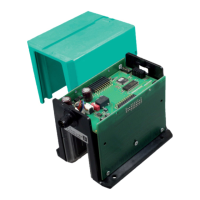
Do you have a question about the Pepperl+Fuchs WCS Series and is the answer not in the manual?
| Series | WCS |
|---|---|
| Protection Degree | IP67 |
| Operating Voltage | 10 ... 30 V DC |
| Operating Current | < 100 mA |
| Operating Temperature | -25°C to +70°C |
| Storage Temperature | -40°C to +85°C |
| Connection | Connector |
| Power Consumption | < 3 W |
Details the information contained within the document for product lifecycle phases.
Defines responsibilities and required qualifications for product handling.
Explains warning and informative symbols used throughout the manual.
Explains the system components: code rail and read head, and their operation.
Lists diverse applications and operational environments for the WCS system.
Describes specifications and routing of shielded data cables for the read head.
Provides step-by-step instructions for opening and closing the read head enclosure.
Details wiring diagrams and cable specifications for RS-485 connectivity.
Explains the use of DIP switches for configuring address, baud rate, and terminator.
Describes available data protocols, byte structure, and response telegrams.
Lists error codes, their causes, and recommended remedies for troubleshooting.
Explains the meaning of different LED indicators for operational status and faults.
Provides wiring diagrams and data cable specifications for SSI interface.
Details DIP switch settings for data format and contamination detection.
Describes the SSI data format, clock signals, and bit meanings.
Lists status and error codes with their respective causes and remedies.
Explains the LED status indicators for the SSI interface.
Details wiring diagrams and data cable specifications for CANopen connectivity.
Explains DIP switch settings for baud rate, node ID, and transfer mode.
Covers integrating the device using EDS files and project planning tools.
Describes the supported CAN data protocols (1 and 2).
Explains the LED indicators for the CANopen interface.
Details wiring diagrams and cable specifications for EtherNet/IP.
Explains DIP switch usage for display rotation.
Covers setting the IP address using DHCP/BOOTP server.
Outlines EtherNet/IP objects, classes, and cyclic data communication.
Explains the LED indicators for the EtherNet/IP interface.
Details wiring diagrams and cable specifications for PROFINET.
Explains DIP switch usage for display rotation.
Covers PROFINET integration, GSDML files, and device identification.
Describes PROFINET data modules for position, speed, and error data.
Explains the LED indicators for the PROFINET interface.
Details the optional integrated display module and its adjustment.
Describes the extended version for routes over 314.573 m.
Explains the optional heating feature for cold or humid environments.
Details the optional velocity output feature and limit speed configuration.
Lists available pre-configured and configurable cables for various interfaces.